Science-Backed Benefits of Yoga for Hernia + Top 11 Yoga Poses for Hernias
The post Science-Backed Benefits of Yoga for Hernia + Top 11 Yoga Poses for Hernias appeared first on The Yoga Nomads.

Yoga is known to strengthen your body from the inside-out. Beyond the physical tone or mental resilience you may develop through a regular practice, yoga is also known to strengthen the internal muscle fascia that holds our organs in place.
There are many yoga postures that are used to prevent or treat hernia in different areas of the body, particularly in the abdominal region.
Research shows that yoga is an effective way to reduce pain and reoccurrence of reversible inguinal hernia in the groin area. Ayurvedic medicine researchers have identified yoga as a key prevention and cure for hernia. Studies have also found that yoga can help control severe GERD and digestive symptoms that result from hiatal hernia in the stomach.
If you are looking for a natural way to treat or prevent hernia, yoga therapy may be an option for you.
However, keep in mind that this is not medical advice and you should consult a doctor before engaging in a new regimen for your health condition.
Can yoga help with hernias?
Hernia occurs when the muscles of the abdominal wall or the connective fascia of the legs are weakened and part of an internal organ bulges out of place. Over 10% of the population experiences a painful hernia in their lifetime, with the most hernias occurring in men.
Whether from lack of physical fitness, lifting a super heavy object, or even chronic coughing, a hernia is a serious medical condition that typically requires hernia surgery.
Yet even after the surgery, doctors recommend maintaining strong abdominal muscles to prevent it from happening again. Thankfully, yoga is the perfect exercise for hernia because it is a low-impact, yet extremely effective way to build core strength and support muscle fascia throughout the body.
How does yoga help hernia?
Key lifestyle changes like weight loss, improved fitness, and better digestive health are often necessary to manage or prevent hernias.
Yoga in particular helps repair weakened muscles and strengthen the connective tissue that keeps vital organs in place to prevent hernia.
When combined with pranayama deep breathing, a regular practice can help build robust core strength and bolster the diaphragm without putting pressure on the abdomen.
To fully understand how yoga helps with hernias, let’s dig into the types and causes of hernia.
Types of Hernia
There are 4 main types of hernia that occur in over 1 million people per year in the United States.
Inguinal Hernia: The most common type of hernia occurs in the inner groin when the bladder or bowel intestines pushes through weak areas of the lower abdominal wall. About 96% of hernias are inguinal and some 27% of men and 3% of women will develop one in their lifetime.Hiatal Hernia: Older adults and smokers tend to be more subject to hernias in the chest region, which occurs when the upper part of the stomach pushes over the diaphragm and into the chest. Hiatal hernia is also linked to acid reflux and gastroesophageal reflux disorder (GERD).Umbilical Hernia: When a part of the intestines bulge through abdominal muscles in the belly button region, it is called an umbilical hernia. This happens most commonly in infants, however it can also affect pregnant women and adult males.Femoral Hernia: When the intestine protrudes through weakened fascia into the upper thigh, a hernia occurs near the femoral artery, which is vital for providing blood to the lower body. Pregnant women or obese women are the most likely to experience femoral hernia.This relatively common medical condition can arise from a wide range of causes that we will explore below, but they all have the same root issue in common: a hernia happens because an organ squeezes through a weak spot in the muscle fascia.
Yoga therapy aims to strengthen the muscle fascia throughout the body to keep your internal organs in place.
Causes of Hernias
Hernias can be caused by a range of different factors:
Weak musclesLack of physical fitnessMuscle strainSurgeryInjuriesChronic constipationLifting something too heavyIndigestion or poor gut healthChronic coughingWeight gainStressAnxietyMany of these issues can be prevented or aided by a regular yoga practice and healthy lifestyle.
Why do yoga for hernia?
The ancient practice of yoga integrates your breath specific movements and postures (asanas). Different asanas stretch and strain your muscles while bringing oxygenated blood to the region. As the center of the body’s balance, the core is almost always engaged during your yoga practice, which is what makes yoga flows so effective for managing hernias.
Different types of yoga can have different effects. For example, gentle Hatha yoga may be best for those who have just undergone hernia surgery, whereas more vigorous Vinayasa yoga can be more helpful for burning calories and aiding in weight loss. Certain sequences such as sun salutation activate every major muscle group in the body while integrating mild cardiovascular exercise as well.
Best of all, most yoga poses don’t put excessive pressure on the abdominal organs. Yoga uses only your body weight and slow, calculated movements to keep you aligned and balanced.
While weightlifting and lifting heavy objects is not recommended when you have a hernia, yoga can provide the perfect low-impact exercise for improving gut health, strengthening your core, and staying athletic.
Benefits of Yoga for Hernia
The benefits of yoga for preventing hernia or healing after hernia surgery are well-established in the scientific literature. Doctors and physical therapists are increasingly recommending yoga therapy
Strengthen the core: One of the key causes of a hernia is a lack of strength in the core. Certain yoga poses activate your abdominal muscles and obliques to help maintain a stronger abdominal wall.Activate smaller muscle fibers and fine muscle fascia: More subtle stretches and movements in yoga are able to target the fiber webbing around your muscles called fascia. As you increase your mobility, you can lengthen and stretch the myofascial connective tissue that aids in keeping your organs in place.Improve body awareness: Linking your breath with your motion helps to connect you with your body and notice areas where you may be feeling pain. Yoga works wonders for people who feel unbalanced or “stuck in their heads” and need to return to their body for relief from stress or anxiety.Recover after hernia surgery: Research shows that post-surgery yoga is important for reducing the pain, symptoms, and recurrence of hernia.What yoga poses to avoid with a hernia?
Not all yoga asanas are particularly helpful for hernia. In fact, it is probably best to avoid intensive yoga practices like Bikram or to practice postures in the prone (face down on your stomach) position when you have a hernia or have recently undergone hernia surgery.
Instead, seek out asanas that fire up all regions of the core, stretch the inguinal region (groin), and can be done with an abdominal lock (uddiyana bandha, explained in the video below).
Best Yoga Poses for Hernia
Here are our top 11 yoga poses for helping with hernia. Most of these postures were specifically selected by researchers specifically because they compress the inguinal canal (where hernia bulges typically happen) and strengthen the abdominal muscles without causing pressure in the abdominal region.
Butterfly Pose (Titli Asana)
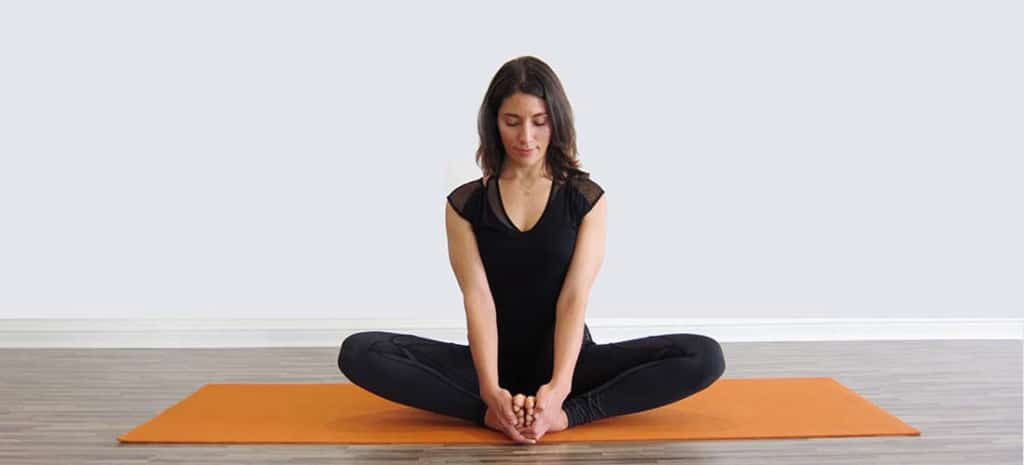
A pleasant inner thigh stretch can be a great way to begin relieving inguinal hernias. Move your feet closer or away from you to alter the intensity of the stretch.
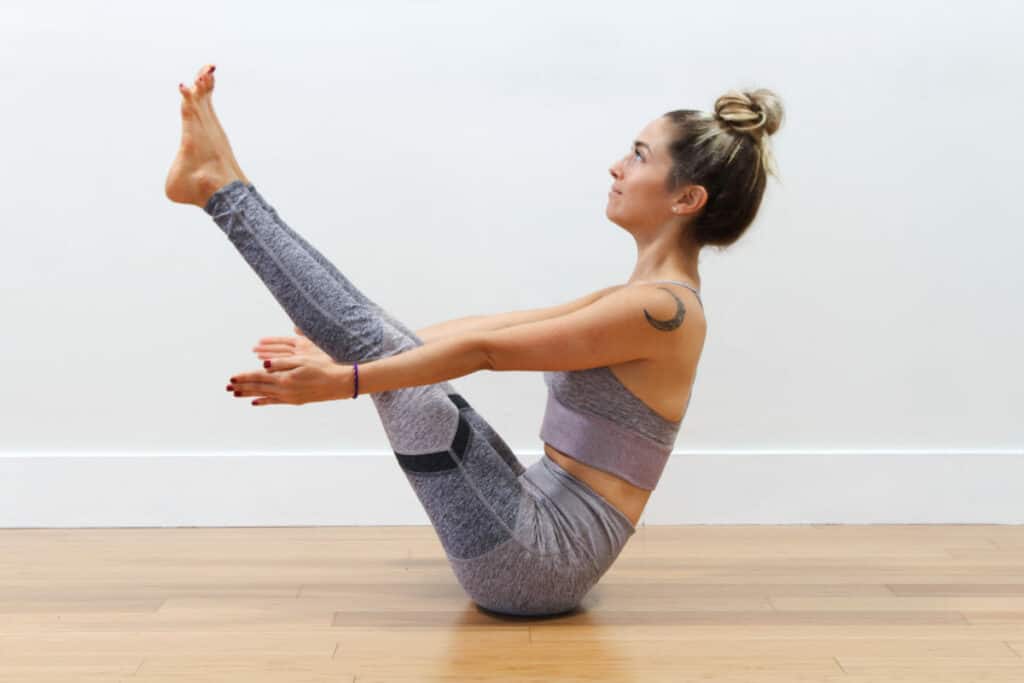
One of the best core strengthening exercises for hernia, Boat Pose will help tone your abs while relieving low back pain and strengthening the upper thighs. Don’t forget to maintain a straight back and use a yoga strap if needed.
Cat/Cow Pose (Chakravakasana)
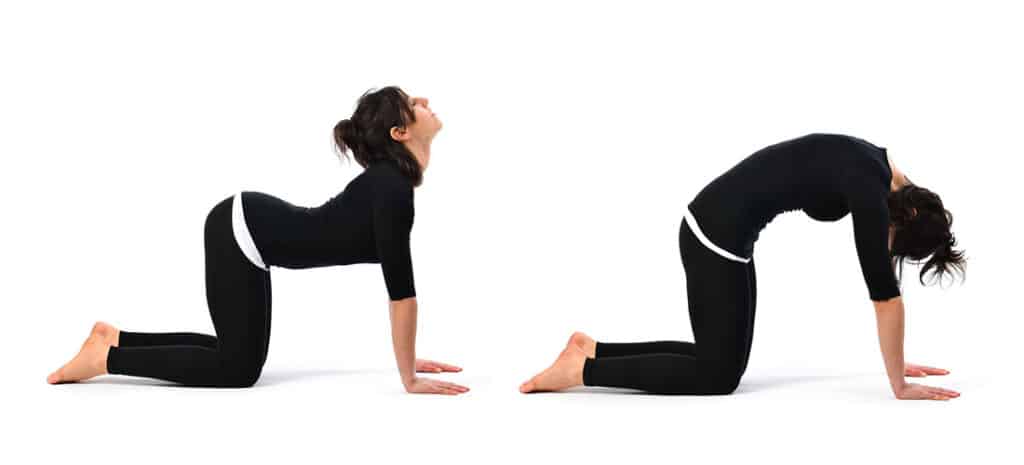
Alternate lengthening and compressing the stomach as your spine arches upward and downward between these postures. Don’t forget to tuck and flex the core in Cat Pose, then release and stretch it as you push your tailbone up during Cow Pose.
Thunderbolt Pose (Vajrasana)

While it may not look like you are doing much, Thunderbolt Pose is actually a remarkable way to strengthen your pelvic floor and improve digestion. As you practice deep breathing with your spine straight, core engaged, and heels beneath your buttocks, you can slowly activate abdominal muscles on every exhale to calm the body and help with hernia.
Camel Pose (Ustrasana)
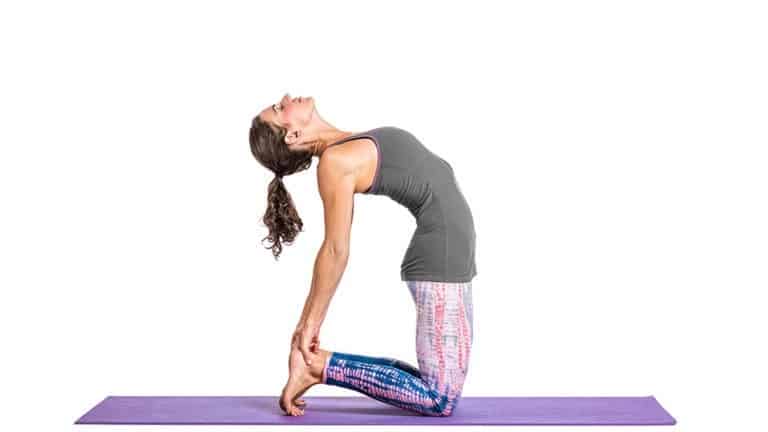
Ustrasana involves lifting the chest to the sky, engaging the glutes forward, and deeply opening the front of the body. You will find yourself engaging your core to keep your spine long and body balanced.
Camel pose is known to open the hip flexors, stretch and strengthen your core, expand the abdominal region to improve digestion, and improve posture.
Though it is one of the best yoga poses for hernia, Camel Pose can be challenging for beginners. It is best to practice this one in a studio with a certified yoga instructor who can guide you through the posture.
Seated Forward Fold (Paschimottanasana)
Seated forward fold lengthens your hamstrings while lightly compressing your stomach without too much pressure. This posture helps with indigestion, strengthens leg muscles, and aids in reducing high blood pressure.
Gas Release Pose (Pawanmuktasana)
This pose does exactly what its name implies: it helps to release stomach gas while lightly massaging your intestines and helping to reduce belly fat. Drawing the thighs in towards the core is great for hernia because it is a gentle yet compressive motion that flexes the abdominal walls.
Raised Feet Pose (Uttanpadasana)
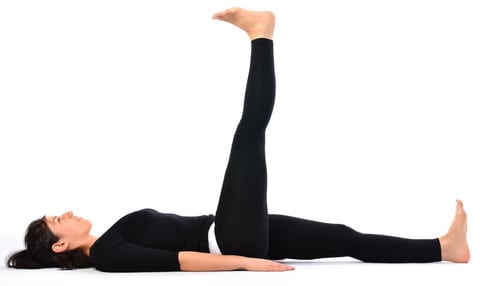
This simple pose for beginner yogis helps to avoid constipation, relieve acid reflux, and strengthen the lower back.
Practice single leg raising with the left leg and then the right. Lastly, hold both legs up for a few breaths to engage the core and fire up your quads.
Fish Pose (Matsyasana)
For a deep heart opener that helps with constipation, relieving inflammation, and stretching many vital organs, try out Fish Pose.
Use a yoga bolster or block to add extra support and comfort in this pose.
Closing Thoughts
In combination with other treatments, yoga can be an incredible preventative and therapeutic practice for healing from a hernia.

 MikeTyes
MikeTyes 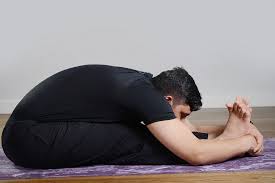




















.jpg&h=630&w=1200&q=100&v=6e07dc5773&c=1)












